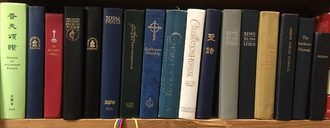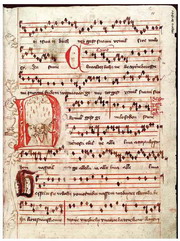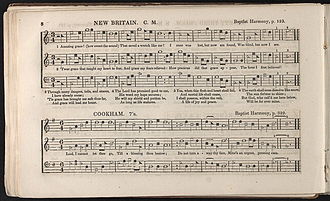
A hymn is a type of song, and partially synonymous with devotional song, specifically written for the purpose of adoration or prayer, and typically addressed to a deity or deities, or to a prominent figure or personification. The word hymn derives from Greek ὕμνος (hymnos), which means "a song of praise". A writer of hymns is known as a hymnist. The singing or composition of hymns is called hymnody. Collections of hymns are known as hymnals or hymn books. Hymns may or may not include instrumental accompaniment.

Shape notes are a musical notation designed to facilitate congregational and social singing. The notation, introduced in late 18th century England, became a popular teaching device in American singing schools. Shapes were added to the noteheads in written music to help singers find pitches within major and minor scales without the use of more complex information found in key signatures on the staff.
"Old 100th" or "Old Hundredth" is a hymn tune in long metre, from the second edition of the Genevan Psalter. It is one of the best known melodies in many occidental Christian musical traditions. The tune is usually attributed to the French composer Louis Bourgeois.

A metrical psalter is a kind of Bible translation: a book containing a verse translation of all or part of the Book of Psalms in vernacular poetry, meant to be sung as hymns in a church. Some metrical psalters include melodies or harmonisations. The composition of metrical psalters was a large enterprise of the Protestant Reformation, especially in its Calvinist manifestation.

Ananias Davisson was a singing school teacher, printer and compiler of shape note tunebooks. He is best known for his 1816 compilation Kentucky Harmony, which is the first Southern shape-note tunebook. According to musicologist George Pullen Jackson, Davisson's compilations are "pioneer repositories of a sort of song that the rural South really liked."
The Kentucky Harmony is a shape note tunebook, published in 1816 by Ananias Davisson. It is the first Southern shape-note tunebook.
Decisions concerning the conduct of public worship in the Church of Scotland are entirely at the discretion of the parish minister. As a result, a wide variety of musical resources are used. However, at various times in its history, the General Assembly has commissioned volumes of psalms and hymns for use by congregations.

The Genevan Psalter, also known as the Huguenot Psalter, is a 1539 metrical psalter in French created under the supervision of John Calvin for liturgical use by the Reformed churches of the city of Geneva in the sixteenth century.
Songs of Syon: A Collection of Hymns and Sacred Poems Mostly Translated from Ancient Greek, Latin and German Sources was produced by George Ratcliffe Woodward in 1904. In 1908, a new and enlarged edition was produced, with the title Songs of Syon: A Collection of Psalms, Hymns and Spiritual Songs for Public and Private Use. While the first edition had 201 items, this later edition had 431. Words and music were published separately. A third edition followed in 1910. A fourth edition, revised and enlarged, came out in 1923. This was primarily a reprint of the third edition, with musical errors corrected on the advice of Dr.Charles Wood. In a few cases, "finer melodies, or better harmonies, have been substituted." The hymnal was described by the writer of Woodward's Church Times obituary as "the finest hymn book, both as regards words and music, ever produced in England."
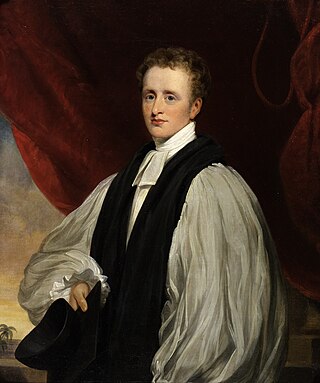
"Holy, Holy, Holy! Lord God Almighty!" is a Christian hymn written by the Anglican bishop Reginald Heber (1783–1826).
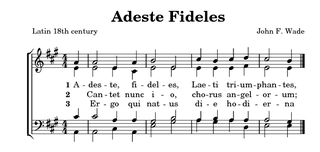
A hymn tune is the melody of a musical composition to which a hymn text is sung. Musically speaking, a hymn is generally understood to have four-part harmony, a fast harmonic rhythm, with or without refrain or chorus.

"The Lord's My Shepherd" is a Christian hymn. It is a metrical psalm commonly attributed to the English Puritan Francis Rous and based on the text of Psalm 23 in the Bible. The hymn first appeared in the Scots Metrical Psalter in 1650 traced to a parish in Aberdeenshire.

"Ach Gott, vom Himmel sieh darein" is a Lutheran chorale of 1524, with words written by Martin Luther paraphrasing Psalm 12. It was published as one of eight songs in 1524 in the first Lutheran hymnal, the Achtliederbuch, which contained four songs by Luther, three by Speratus, and one by Justus Jonas. It was contained in 1524 in the Erfurt Enchiridion. It is part of many hymnals, also in translations. The text inspired vocal and organ music by composers such as Heinrich Schütz, who set it as part of his Becker Psalter, and Johann Sebastian Bach, who based a chorale cantata on it. Mozart used one of its tunes in his opera The Magic Flute.

"Aus tiefer Not schrei ich zu dir", originally "Aus tieffer not schrey ich zu dir", later also "Aus tiefer Noth schrei' ich zu dir", is a Lutheran hymn of 1524, with words written by Martin Luther as a paraphrase of Psalm 130. It was first published in 1524 as one of eight songs in the first Lutheran hymnal, the Achtliederbuch, which contained four songs by Luther, three by Paul Speratus, and one by Justus Jonas, and also appeared the same year in the Erfurt Enchiridion. It is part of many hymnals, also in translations. The text inspired vocal and organ music from the Renaissance to contemporary, including composers such as Johann Sebastian Bach, who based a chorale cantata on it, Felix Mendelssohn and Max Reger.

The First Lutheran hymnal, published in 1524 as Etlich Cristlich lider / Lobgesang und Psalm, often also often referred to as the Achtliederbuch, was the first Lutheran hymnal.
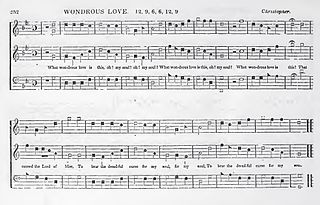
"What Wondrous Love Is This" is a Christian folk hymn from the American South. Its text was first published in 1811, during the Second Great Awakening, and its melody derived from a popular English ballad. Today it is a widely known hymn included in hymnals of many Christian denominations.
Hymnody in continental Europe developed from early liturgical music, especially Gregorian chant. Music became more complicated as embellishments and variations were added, along with influences from secular music. Although vernacular leisen and vernacular or mixed-language carols were sung in the Middle Ages, more vernacular hymnody emerged during the Protestant Reformation, although ecclesiastical Latin continued to be used after the Reformation. Since then, developments have shifted between isorhythmic, homorhythmic, and more rounded musical forms with some lilting. Theological underpinnings influenced the narrative point of view used, with Pietism especially encouraging the use of the first person singular. In the last several centuries, many songs from Evangelicalism have been translated from English into German.
Church music during the Reformation developed during the Protestant Reformation in two schools of thought, the regulative and normative principles of worship, based on reformers John Calvin and Martin Luther. They derived their concepts in response to the Catholic church music, which they found distracting and too ornate. Both principles also pursued use of the native tongue, either alongside or in place of liturgical Latin.

John Wyeth (1770–1858) was a printer in Harrisburg, Pennsylvania who is best-known for printing Wyeth's Repository of Sacred Music, Part Second, which marks an important transition in American music. Like the original Repository of 1810, Part Second used the four-shape system of Little and Smith in The Easy Instructor to appeal to a wider audience; but its pioneering inclusion American folk tunes influenced all subsequent folk hymn, camp meeting, and shape note collections. Musicologist Warren Steel sees Wyeth's Repository of Sacred Music, Part Second as marking "the end of the age of New England composer-compilers (1770-1810) and the beginning of the age of southern collector-compilers (1816-1860)."
